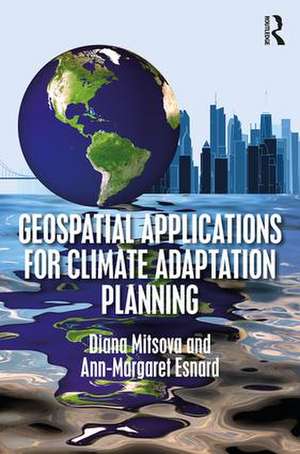Geospatial Applications for Climate Adaptation Planning
Autor Diana Mitsova, Ann-Margaret Esnarden Limba Engleză Hardback – 13 dec 2018
Geospatial Applications for Climate Adaptation Planning presents an overview of the range of strategies, tools, and techniques that must be used to assess myriad overlapping vulnerabilities and to formulate appropriate climate-relevant solutions at multiple scales and in varying contexts. Organized into four sections, the book includes 15 chapters. Each chapter is grounded in the literature and presents case studies designed by the authors, as well as many examples from a diverse international group of scholars and entities in the public and private sectors. Areas covered include:
- Climate Change and Climate Adaptation Planning: Context and Concepts
- Geospatial Technologies: Fundamentals and Terminology
- GIS and Climate Vulnerability Assessments
- Technical Approaches to Formulating Mitigation and Adaptation Strategies
Preț: 1006.60 lei
Preț vechi: 1227.57 lei
-18% Nou
Puncte Express: 1510
Preț estimativ în valută:
192.64€ • 200.37$ • 159.03£
192.64€ • 200.37$ • 159.03£
Carte tipărită la comandă
Livrare economică 15-29 aprilie
Preluare comenzi: 021 569.72.76
Specificații
ISBN-13: 9781498755481
ISBN-10: 1498755488
Pagini: 358
Ilustrații: 76 Line drawings, black and white; 8 Tables, black and white; 76 Illustrations, black and white
Dimensiuni: 156 x 234 x 21 mm
Greutate: 0.64 kg
Ediția:1
Editura: Taylor & Francis
Colecția Routledge
Locul publicării:Oxford, United Kingdom
ISBN-10: 1498755488
Pagini: 358
Ilustrații: 76 Line drawings, black and white; 8 Tables, black and white; 76 Illustrations, black and white
Dimensiuni: 156 x 234 x 21 mm
Greutate: 0.64 kg
Ediția:1
Editura: Taylor & Francis
Colecția Routledge
Locul publicării:Oxford, United Kingdom
Public țintă
Postgraduate, Professional, Professional Practice & Development, and UndergraduateCuprins
1. Introduction Part 1: Climate Change and Climate Adaptation Planning: Context and Concepts 2. Climate Change: Historical Context and Global Initiatives 3. Climate Adaptation: A Nexus of Science, Policy, and Planning 4. Addressing Climate Change: Initiatives and Coping Strategies from Across the Globe Part 2: Geospatial Technologies: Fundamentals and Terminology 5. Natural Hazards: Visualization and Basic Mapping 6. Spatial Analysis and GIS Modeling 7. Climate Hazard Assessment and Adaptation Indicators 8. Applications of Remote Sensing and GIS in Climate Change Assessments Part 3: GIS and Climate Vulnerability Assessments 9. Mapping and Assessing the Impacts of SLR on Coastal Regions 10. Vulnerability of Critical Infrastructure to Climate Impacts 11. Assessing the Impact of Rising Temperatures and Urban Heat Islands on People and Places 12. Climate Hazards and Impact on Public Health Part 4: Technical Approaches to Formulating Mitigation and Adaptation Strategies 13. Climate Resilience of Urban Systems and Interdependent Infrastructures 14. Urban Growth Modeling and Decision Support Systems 15. Internet-Based GIS Applications to Facilitate the Adaptation of the Built Environment to Climate Change
Notă biografică
Diana Mitsova is Associate Professor in the School of Urban and Regional Planning and Director of the Visual Planning Technology Lab at Florida Atlantic University. Her research focuses on the use of geographic information systems in disaster planning, critical infrastructure protection, coastal resilience, and climate adaptation of urban systems. Her research has been funded by the National Science Foundation, USGS, the National Park Service, The Nature Conservancy, and the Florida Sea Grant. She holds a Master’s of Public Affairs from the School of Public and Environmental Affairs at Indiana University–urdue University, Indianapolis, and a Ph.D. in Regional Development Planning from the University of Cincinnati. She is also a recipient of a NATO Democratic Institutions Research Fellowship.
Ann-Margaret Esnard is a Distinguished University Professor in the Department of Public Management and Policy at Georgia State University. Her expertise encompasses urban planning, disaster planning, and hazard and vulnerability assessment. Esnard has been involved in a number of research initiatives, including NSF-funded projects on the topics of population displacement from catastrophic disasters, school recovery after disasters, long-term recovery, and community resilience. She holds degrees in Agricultural Engineering (B.Sc., University of the West Indies–Trinidad), Agronomy and Soils (M.S., University of Puerto Rico–Mayaguez), and Regional Planning (Ph.D., UMASS–Amherst). She also completed a two-year post-doc at UNC–Chapel Hill.
Ann-Margaret Esnard is a Distinguished University Professor in the Department of Public Management and Policy at Georgia State University. Her expertise encompasses urban planning, disaster planning, and hazard and vulnerability assessment. Esnard has been involved in a number of research initiatives, including NSF-funded projects on the topics of population displacement from catastrophic disasters, school recovery after disasters, long-term recovery, and community resilience. She holds degrees in Agricultural Engineering (B.Sc., University of the West Indies–Trinidad), Agronomy and Soils (M.S., University of Puerto Rico–Mayaguez), and Regional Planning (Ph.D., UMASS–Amherst). She also completed a two-year post-doc at UNC–Chapel Hill.
Recenzii
'The authors have provided a remarkably comprehensive discussion of many topics relating to planning for climate change. No matter your background and prior knowledge, you will be rewarded with new insights from this book.' - John Ottensmann, Professor Emeritus, Indiana University-Purdue University Indianapolis
'This is an excellent and timely overview of the methods and tools for assessing climate-related vulnerabilities and identifying solutions through the use of GIS. The authors describe traditional GIS functionalities as well as emerging geospatial technologies that have great potential to assist in research and operations and to inform climate adaptation policy. Educators, students, and practitioners will find this book a useful resource, as it presents a balanced combination of theory, methods, and practical GIS examples.' - Olga Wilhelmi, National Center for Atmospheric Research
'This is an excellent and timely overview of the methods and tools for assessing climate-related vulnerabilities and identifying solutions through the use of GIS. The authors describe traditional GIS functionalities as well as emerging geospatial technologies that have great potential to assist in research and operations and to inform climate adaptation policy. Educators, students, and practitioners will find this book a useful resource, as it presents a balanced combination of theory, methods, and practical GIS examples.' - Olga Wilhelmi, National Center for Atmospheric Research
Descriere
Presents an overview of the range of strategies, tools, and techniques that must be used to assess myriad overlapping vulnerabilities and to formulate appropriate climate-relevant solutions at multiple scales and in varying contexts.
